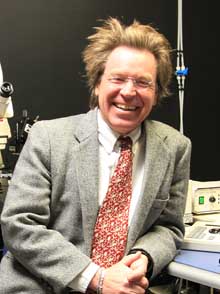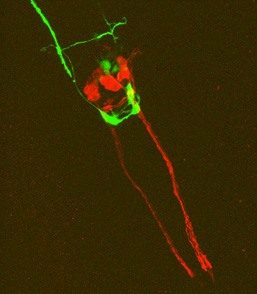Erik Jorgensen
Distinguished Professor of Biological Sciences, Adjunct Distinguished Professor of Human Genetics, and Adjunct Professor of Biomedical Engineering
Genetics of Neurotransmission, Synapse Formation and Modulation

Molecular Biology Program
Education
B.S. University of California, Berkeley
Ph.D. University of Washington
Research
What is the molecular nature of memory? It seems that memory is encoded by changes in the strength of synapses. It is our goal to identify the molecules that function at the synapse and to understand how the activities of these molecules are changed to strengthen or weaken a synapse. To identify such molecules we have undertaken a genetic analysis of neurotransmission in the nematode Caenorhabditis elegans. C. elegans is particularly advantageous for genetic studies of the nervous system for several reasons: First, mutants with defective synapses are viable and can be studied as adults. Second, we can select for mutants with defective neurotransmission using drug resistance screens. Third, we can characterize mutant synapses at the ultrastructural and electrophysiological level. Fourth, the entire genomic sequence of the nematode has been completed; and knockouts of many genes have been generated; this greatly expedites the characterization of genes.
Our goal is to identify the genes required for synaptic function. Such genes are likely
to regulate synaptic vesicle dynamics. When a neuron fires an action potential, calcium
ions flow into the axonal terminus of the presynaptic cell. Calcium influx causes
synaptic vesicles to fuse with the plasma membrane and to release neurotransmitter
to the surface of the neighboring cell.
What is the molecular mechanism of vesicle fusion? In our screens we have identified
UNC-13, UNC-18 and the SNARE proteins. We are characterizing the molecular interactions
that drive fusion. Using electrophysiological recordings and analysis of vesicles
by electron microscopy we have determined that these proteins are required for docking
and priming vesicles for release at the cell membrane.
What are the molecular mechanisms of synaptic vesicle retrieval? Once synaptic vesicles have fused with the plasma membrane, the components must be retrieved from the plasma membrane via endocytosis to regenerate a reserve pool of vesicles. We are studying clathrin-mediated endocytosis and lipid modifying proteins that are essential for endocytosis.
What are the mechanisms for synaptic plasticity? We are currently studying the role
of GTPases in potentiating or weakening synaptic strength. Our data indicate that
Gq subunits of trimeric G proteins have novel targets beyond the lipid modifying enzymes
of the canonical pathway.
What neurotransmitters function at synapses? GABA is the primary inhibitory neurotransmitter
in vertebrate and invertebrate nervous systems. Our analysis of GABA has demonstrated
that GABA is an excitatory neurotransmitter at both neurons and muscles in the nematode.
Moreover, we have discovered that protons can act as a transmitter at some synapses.
These studies suggest that there is an unforeseen richness to the molecular complexity
of the nervous system – and hence the brain.

References
- Mueller BD, Merrill SA, Watanabe S, Liu P, Niu L, Singh A, Maldonado-Catala P, Cherry A, Rich MS, Silva M, Maricq AV, Wang ZW, Jorgensen EM (2023) CaV1 and CaV2 calcium channels mediate the release of distinct pools of synaptic vesicles. Elife. Feb 23;12:e81407. doi: 10.7554/eLife.81407. PMID: 36820519.
- Watanabe S, Mamer LE, Raychaudhuri S, Luvsanjav D, Eisen J, Trimbuch T, Söhl-Kielczynski B, Fenske P, Milosevic I, Rosenmund C, Jorgensen EM (2018) Synaptojanin and endophilin mediate neck formation during ultrafast endocytosis. Neuron. 27:1184-1197.
- Frøkjær-Jensen C, Jain N, Hansen L, Davis MW, Li Y, Zhao D, Rebora K, Millet JR, Liu X, Kim SK, Dupuy D, Jorgensen EM, Fire AZ (2016) An Abundant Class of Non-coding DNA Can Prevent Stochastic Gene Silencing in the C. elegans Germline. Cell 166, 343-57.
- Schwartz ML, Jorgensen EM (2016) SapTrap, a Toolkit for High-Throughput CRISPR/Cas9 Gene Modification in Caenorhabditis elegans. Genetics 202, 1277-88.
- Watanabe S, Trimbuch T, Camacho-Pérez M, Rost BR, Brokowski B, Söhl-Kielczynski B, Felies A, Davis MW, Rosenmund C, Jorgensen EM (2014) Clathrin regenerates synaptic vesicles from endosomes. Nature 515, 228-33.
- Hollopeter G, Lange JJ, Zhang Y, Vu TN, Gu M, Ailion M, Lambie EJ, Slaughter BD, Unruh JR, Florens L, Jorgensen EM (2014) The membrane-associated proteins FCHo and SGIP are allosteric activators of the AP2 clathrin adaptor complex. Elife 2014 Oct 10; 3.
- Frøkjær-Jensen C, Davis MW, Sarov M, Taylor J, Flibotte S, LaBella M, Pozniakovsky A, Moerman DG, Jorgensen EM (2014) Random and targeted transgene insertion in C. elegans using a modified Mos1 transposon. Nature Methods 11, 529-534.
- Ailion M, Hannemann M, Dalton S, Pappas A, Watanabe S, Hegermann J, Liu Q, Han HF, Gu M, Goulding MQ, Sasidharan N, Schuske K, Hullett P, Eimer S, Jorgensen EM (2014) Two Rab2 Interactors Regulate Dense-Core Vesicle Maturation. Neuron 82, 167-180.
- Rawson RL, Yam L, Weimer RM, Bend EG, Hartwieg E, Horvitz HR, Clark SG, Jorgensen EM (2014) Axons degenerate in the absence of mitochondria in C. elegans. Current Biology 24, 760-765.
- Watanabe S, Rost BR, Camacho-Pérez M, Davis MW, Söhl-Kielczynski B, Rosenmund C, Jorgensen EM (2013) Ultrafast endocytosis at mouse hippocampal synapses. Nature 504, 242-7. doi: 10.1038/12809.
- Peden AS, Mac P, Fei YJ, Castro C, Jiang G, Murfitt KJ, Miska EA, Griffin JL, Ganapathy V, Jorgensen EM (2013) Betaine acts on ligand-gated ion channel in the nervous system of the nematode C. elegans. Nature Neuroscience 16, 1794-1801.
- Watanabe S, Liu Q, Davis MW, Hollopeter G, Thomas N, Jorgensen NB, Jorgensen EM (2013) Ultrafast endocytosis at the C. elegans neuromuscular junction. eLife 2, e00723.
- Gu M, Liu Q, Watanabe S, Sun L, Hollopeter G, Grant BD, Jorgensen EM (2013) AP2 hemicomplexes contribute independently to synaptic vesicle endocytosis. eLife 2, p00190.
- White JQ and Jorgensen EM (2012) Sensation in a single neuron pair represses male behavior in hermaphrodites. Neuron 75, p593-600.
- Ernstrom GG, Weimer R, Pawar DR, Watanabe S, Hobson RJ, Greenstein D, Jorgensen EM (2012) The V-ATPase V1 sector is required for corpse clearance and neurotransmission in Caenorhabditis elegans. Genetics 191, p461-475.
- Frøkjær-Jensen C, Davis MW, Ailion M, Jorgensen EM (2012) Improved Mos1-mediated transgenesis in C. elegans. Nature Methods 9, p117-118.
- Hobson RJ, Liu Q, Watanabe S, Jorgensen EM (2011) Complexin maintains vesicles in the primed state in C. elegans. Current Biology 21, p106-113.
- Hammarlund M, Nix P, Hauth L, Jorgensen EM, Bastiani M (2009) Axon regeneration requires a conserved MAP kinase pathway. Science 323, p802-806.
